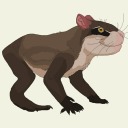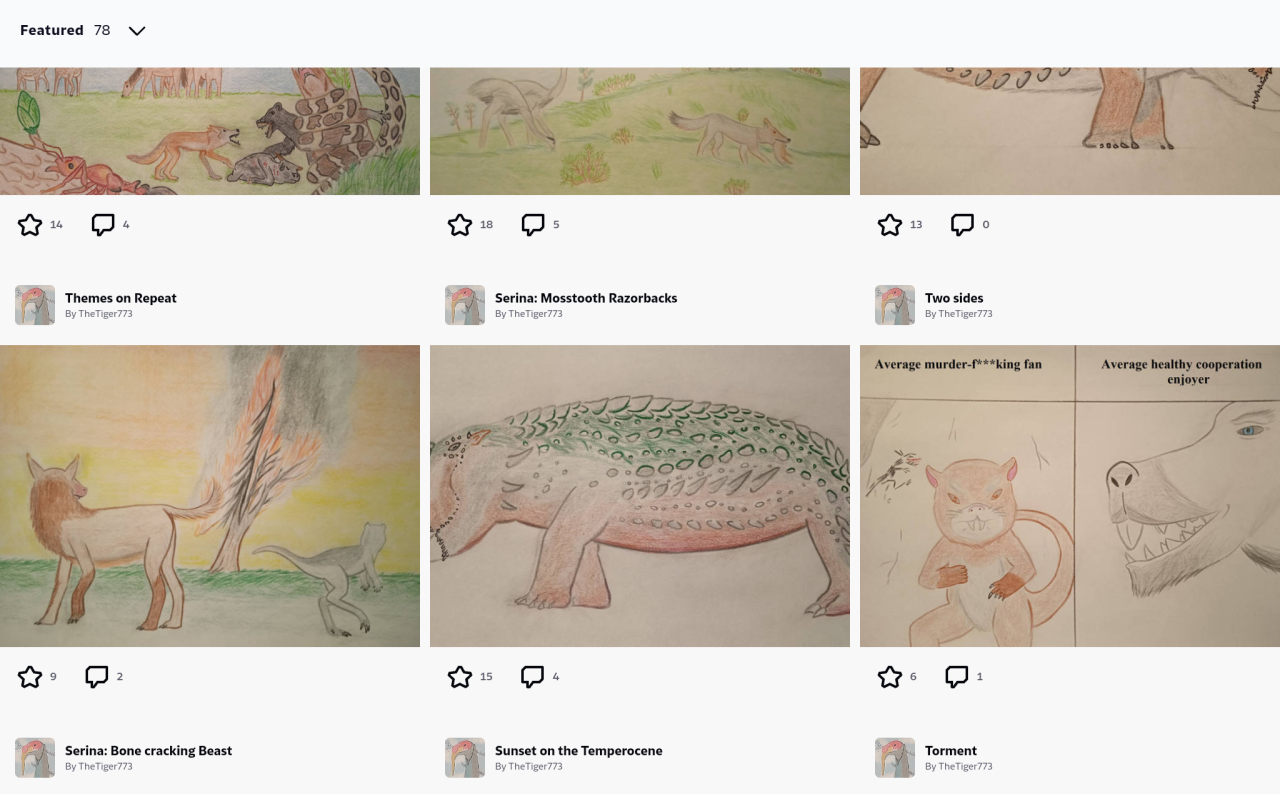The tetracorns are a group of remarkable ungulopes native to Austro-Easaterra, with a most unusual trait: their highly-pronounced sexual dimorphism. While females are smaller, and drably colored, males boast four huge prominent horns and striking patterns, even ones of peculiar colors, thanks to pigments in their diet that accumulate in their skin and hair as a marker of a well-fed, and thus strong and fit, individual.
One of the largest tetracorn species is the fourform fourhorn (Quadratus colossaeus), whose males can grow to three tons or more and sport a distinctive dull muddy-yellow hue of their hair and a pale saddle-like marking on their backs, in contrast to the female’s browner, earthy tones. Like many of the larger tetracorn species, they are monogamous for the breeding season: one male and one female pair up to guide and defend their calves, usually born two at a time as twins, together as a pair (though often split up after the young disperse and may take a new mate the next breeding season), and herds of them consists of mated pairs and their young grazing and traveling in close proximity: yet noticeably segregated in small groups of four, two parents and two children.
Yet something most peculiar has happened to this particular species: a gene that guides the growth and hormonal activity in male tetracorns flipped in a chromosomal inversion, several million years ago, and became passed down as an inverted mutant copy of this gene. This has also reversed its function, leading to rapid growth and later sexual maturity in a female, as opposed to a male, which in turn displays a more gradual growth rate and an earlier sexual maturity like a female if it inherits this gene. Thus, fourhorns that inherit the mutant gene display a reversed sexual dimorphism size-wise, though still retaining their color patterns as those are governed by a separate, unrelated gene and affect a different androgen hormone. Present on one copy of each gene, half of the offspring of a fourhorn with the mutant gene will also exhibit the gene themselves if they mate with a normal partner.
But what has allowed this gene to proliferate and become widespread in their population is the way the resulting differences affect the fourform fourhorn’s social behavior. Being larger and physically stronger, the males, or specifically, large-morph (normal) males are bigger as to defend their single bonded mate from rival bachelors during the breeding season and the resulting calves from predators during their vulnerable first year, while, being smaller and less powerful, small-morph females would rather seek out and prefer pairing with large-morph males for safety. As such, it would seem that normals would pair off only with normals, and mutants only with mutants with smaller males conversely relying on bigger females, resulting to those two groups eventually reproductively isolating from each other’s gene pools and becoming separate species.
Yet, with predators like blubbears and lipgrips to concern them, calves born to a large-morph male and a large-morph female have two stronger parents to defend them and have a greatly heightened survival rate, and so, over time, these pairings became more frequent and more favored by natural selection: leaving small-morph males to pair off only with small-morph females, which compensate for their smaller size by gathering in larger groups to find safety in numbers. Thus, by usually segregating their mate selection to a partner of a similar size, they, inadvertently, make mutant + normal pairings the vast majority of mated pairs over normal + normal and mutant + mutant pairs, ensuring that the mutants and normals’ genes keep mixing and preventing them from diverging into separate gene pools, and also allowing the mutant genes of large-morph females and small-morph males to persist as, by mating with normals more frequently, half of the resulting offspring are mutants, and half are normals.
The fourform fourhorn has thus, in essence, evolved a pseudo-sex chromosome that determines its morphology based on its sex–and functionally has become a species with four “sexes”: large-morph normal male, small-morph normal female, large-morph mutant female and small-morph mutant male. To the pairs of large-morphs, their combined might against enemies virtually guarantees that both calves make it to their first year. To the pairs of small-morphs, less-favorable “left-overs”, they have instead resorted to adaptive gregarious behaviors to compensate for the less-than-ideal circumstances. Either way, the next generation, generally a half-and-half mix of normals and mutants, become independent at about two years of age and disperse: forming loose herds that include random assortments of all four forms, until they pair up in the next mating season, often every two to three years in the spring or summer, depending on food availability in each particular year.
———–
















